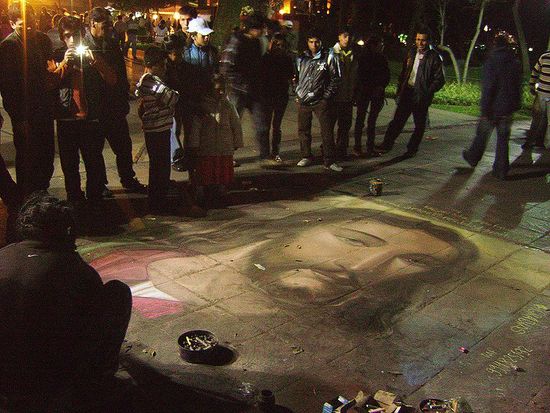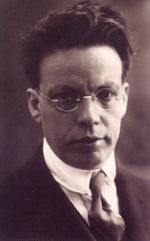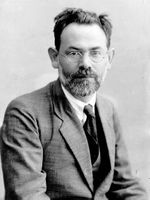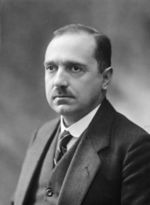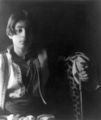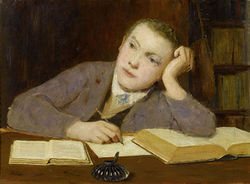Difference between revisions of "Category:Historical Jesus Studies--1920s"
| Line 19: | Line 19: | ||
|px= 38 | |px= 38 | ||
|content= | |content= | ||
[[File:Giovanni Papini.jpg|thumb|150px|[[Giovanni Papini]]]] | |||
[[File:Joseph Klausner.jpg|thumb|150px|[[Joseph Klausner]]]] | [[File:Joseph Klausner.jpg|thumb|150px|[[Joseph Klausner]]]] | ||
[[File:Rudolf Bultmann.jpg|thumb|150px|[[Rudolf Bultmann]]]] | [[File:Rudolf Bultmann.jpg|thumb|150px|[[Rudolf Bultmann]]]] | ||
The 1920s were characterized by the success of | The 1920s were characterized by the success of some very popular fictional works on Jesus--[[La storia di Cristo (1921 Papini), novel]]; [[The King of Kings (1927 DeMille), film]], [[Jesus, the Son of Man (1928 Gibran), poetry]], and [[The Escaped Cock (1928 Lawrence), novel]]. There was now a global market that included authors of different countries, serving an international audience. | ||
Among scholarly works, the most significant contribution was that offered by [[Joseph Klausner]]. His Life of Jesus, written in Hebrew from the perspective of an observant Jew and translated into English by [[Herbert Danby]], was the first consistent attempt to reclaim Jesus from the perspective of the Jewish orthodox tradition. However, a general skepticism about the possibility and even the theological significance of the search for the Historical Jesus became dominant, supported by the authority of [[Rudolf Bultmann]], who in his 1926 book on Jesus concluded that the only Jesus we can know is the risen Christ of the Christian faith. Besides his historical existence, virtually nothing can be recovered of the historical Jesus. The quest for the historical Jesus had therefore to be abandoned as both historically impossible and theologically superfluous. | |||
<gallery> | |||
File:Jesus Film DeMille.gif|[[Cecil B. DeMille]] | |||
File:Kahlil Gibran.jpg|[[Kahlil Gibran]] | |||
</gallery> | |||
}} | }} | ||
{{WindowMain | {{WindowMain | ||
Revision as of 00:56, 21 August 2015
|
The 1920s were characterized by the success of some very popular fictional works on Jesus--La storia di Cristo (1921 Papini), novel; The King of Kings (1927 DeMille), film, Jesus, the Son of Man (1928 Gibran), poetry, and The Escaped Cock (1928 Lawrence), novel. There was now a global market that included authors of different countries, serving an international audience. Among scholarly works, the most significant contribution was that offered by Joseph Klausner. His Life of Jesus, written in Hebrew from the perspective of an observant Jew and translated into English by Herbert Danby, was the first consistent attempt to reclaim Jesus from the perspective of the Jewish orthodox tradition. However, a general skepticism about the possibility and even the theological significance of the search for the Historical Jesus became dominant, supported by the authority of Rudolf Bultmann, who in his 1926 book on Jesus concluded that the only Jesus we can know is the risen Christ of the Christian faith. Besides his historical existence, virtually nothing can be recovered of the historical Jesus. The quest for the historical Jesus had therefore to be abandoned as both historically impossible and theologically superfluous.
|
Cognate Fields (1920s)
|
Pages in category "Historical Jesus Studies--1920s"
The following 63 pages are in this category, out of 63 total.
1
- If Jesus Did Not Die upon the Cross (1920 Docker), arch-fi
- A Jewish View of Jesus (1920 Enelow), book
- The Wandering Jew (1920 Thurston), play
- St Mark Passion (1920 Wood), cantata
- The Coming of the King (1921 Babcock), novel
- Der Galiläer (The Galilean / 1921 Buchowetzki), feature film
- Die Geschichte der synoptischen Tradition (The History of the Synoptic Tradition / 1921 Bultmann), book
- La vie cachée de Jésus (1921 Guignebert), book
- Yerusholaim un Roym: historisher roman oys der tsayt fon bais-sheni = Ben-Hur: A Tale of the Christ (1921 @1880 Wallace / Rejzen), novel (Yiddish ed.)
- Jesus of Nazareth: A Biography (1922 Barton), book
- Jesus-Jeshua (1922 Dalman), book
- Vie de N.S. Jésus-Christ (The Life of Christ / 1922 Fillion), book
- Yeshu ha-Notsri (Jesus of Nazareth / 1922 Klausner), book
- Detti di Gesù (1922 Picherle), book
- Christus Rex (1922 Ryelandt), oratorio
- Les logia agrapha (1923 Besson), book
- L'énigme de Jésus (The Enigma of Jesus / 1923 Couchoud), non-fiction
- Pochodzenie chrzescijanstwa = Der Ursprung des Christentums (Foundations of Christianity / 1923 @1908 Kautsky / Hempel), book (Polish ed.)
- La passione di Cristo (1923 Pea), play
- The Teaching of Jesus and the Jewish Teaching of His Age (1923 Walker), book
- Rex amoris--The King of Love (1923 Wind), novel
- Jézus élete és a vallástörténet = The Life of Jesus and the History of Religion (1923 Zubriczky), book
- La passione di Cristo (1924 Colantuoni), play
- Le mystère de Jésus (The Mystery of Jesus / 1924 Couchoud), non-fiction
- Kristuksen historia = Storia di Cristo (Life of Christ / 1924 @1921 Papini / Hedman), non-fiction (Finnish ed.)
- Men Who Met Jesus (1924 Williams), novel
- Sagnet om Jesus (The Legend of Jesus / 1925 Brandes), book
- The Man Nobody Knows (1925 Burton), nonfiction book
- Le problème du miracle dans le christianisme primitif (The Problem of Miracle in Primitive Christianity / 1925 Fridrichsen), book
- Jésus de Nazareth: mythe ou histoire? (1925 Goguel), book
- Foundations of Christianity = Der Ursprung des Christentums (1925 @1908 Kautsky / Mins), book (English ed.)
- The Man Nobody Knows (1925 Kenepp), film
- The Trial of Jesus (1925 Masefield), play
- Krisztus története = Storia di Cristo (Life of Christ / 1925 @1921 Papini / Fülep), non-fiction (Hungarian ed.)
- 评基督抹殺論 (1925 Sheng), book
- Gesù nella storia: al centro della critica biblica (1925 Tondelli), book
- What Jesus Read: His Dependence and Independence (1925 Walker), book
- Through Human Eyes (1925 Williams), novel
- The Master and His friends (1925 Wilson), novel
- (+) Jesus (Jesus and the Word / 1926 Bultmann), book
- Gesù il Cristo (1926 Buonaiuti), book
- Il mistero di Gesù = Le mystère de Jésus (The Mystery of Jesus / 1926 @1924 Couchoud / Treves), non-fiction (Italian ed.)
- Jesus the Nazarene: Myth or History? (1926 Goguel / Stephens), book (English ed.)
- Bible Dramas in the Pulpit (1926 Stackhouse), play
- Les Judas de Jésus (1927 Barbusse), novel
- Jesus: A New Biography (1927 Case), book
- Ho Hyios tou oikou David (1927 Ingraham / Potamianos), novel (Greek ed.)
- Jesus of Nazareth (1928 Conover), feature film
- (++) Jesus, the Son of Man (1928 Gibran), poetry
- (+) The Escaped Cock (1928 Lawrence), novel
- The Son of Man: The Story of Jesus = Der Menschensohn: Geschichte eines Propheten (1928 Ludwig / Paul), non-fiction (English ed.)
- The Coming of Christ (1928 Masefield), play
- Il primo evangelo (1928 Moccia), arch-fi
- Dog Jesus på korset? = Jesus Died on the Cross? (1928 Toll), arch-fi book
- The Black Christ (1929 Cullen), poetry
- Jesus-Jeshua (1929 Dalman / Levertoff), book (English ed.)
- حياة المسيح = Storia di Cristo (Life of Christ / 1929 @1921 Papini), non-fiction (Arabic ed.)
- From Locke to Reitzenstein: The Historical Investigation of the Origins of Christianity (1929 Salvatorelli), essay
- Samanburður samstofna Guðspjallanna (Harmony of the Four Gospels / 1929 Sívertsen), book (Icelandic)
- Slings and Sandals (1929 Whitehead), novel
- The Glory of Easter (1984 Dunn), play
Media in category "Historical Jesus Studies--1920s"
The following 8 files are in this category, out of 8 total.
- 1921 * Papini (novel).jpg 333 × 499; 25 KB
- 1921 Bennet (film).jpg 214 × 317; 16 KB
- 1923 Wiene (film).jpg 300 × 426; 25 KB
- 1925 * Klausner en.jpg 309 × 500; 19 KB
- 1925 * Niblo (film).jpg 406 × 599; 81 KB
- 1927 DeMille (film).jpg 348 × 490; 76 KB
- 1927 Duvivier (film).jpg 235 × 300; 28 KB
- 1929 Robson.jpg 178 × 284; 3 KB
